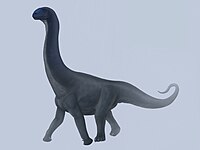Rutland Formation
Topic: Earth
 From HandWiki - Reading time: 2 min
From HandWiki - Reading time: 2 min
| Rutland Formation Stratigraphic range: Bajocian-Bathonian | |
|---|---|
| Type | Formation |
| Unit of | Great Oolite Group |
| Sub-units | Stamford Member, Thorncroft Sand Member, Wellingborough Limestone Member |
| Underlies | Blisworth Limestone, White Limestone Formation |
| Overlies | Lincolnshire limestone, Northampton Sand Formation |
| Thickness | Typically about 8 to 12m, up to 15m |
| Lithology | |
| Primary | Mudstone |
| Other | Limestone |
| Location | |
| Region | England |
| Country | United Kingdom |
The Rutland Formation is a geologic formation in England . It preserves fossils dating back to the late Bajocian to Bathonian stages in the Jurassic period, about 169 million years ago. It is the lateral equivalent of the Sharp's Hill Formation and the Fuller's Earth Formation. The "Rutland Dinosaur" specimen of Cetiosaurus is known from the formation.[1]
Paleobiota
| Genus | Species | Dist. | Member | Material | Notes | Images |
|---|---|---|---|---|---|---|
|
C. oxoniensis[2] |
Great Casterton Quarry | Freshwater Series |
"Rutland Dinosaur" specimen consisting of " cervicals `2±14', some with ribs of the left or both sides; neural arches, spinesor centra of at least 11 dorsals and many thoracic rib fragments; at least four sacral centra, with parts of theparapophyses; four sacral ribs and possible sacral spines; 13 anterior caudals; several damaged chevrons;fragments of both ilia and the left ischium; and the right femur."[1] |
|||
| Sauropoda | Indet | Woodeaton Quarry | Undescribed.[3] | |||
| Dinosauria |
See also
- List of fossiliferous stratigraphic units in England
- List of dinosaur-bearing rock formations
References
- ↑ 1.0 1.1 Upchurch, Paul; Martin, John (November 2002). "The Rutland Cetiosaurus: the anatomy and relationships of a Middle Jurassic British sauropod dinosaur" (in en). Palaeontology 45 (6): 1049–1074. doi:10.1111/1475-4983.00275. ISSN 0031-0239.
- ↑ 2.0 2.1 Weishampel, David B; et al. (2004). "Dinosaur distribution (Middle Jurassic, Europe)." In: Weishampel, David B.; Dodson, Peter; and Osmólska, Halszka (eds.): The Dinosauria, 2nd, Berkeley: University of California Press. Pp. 538–541. ISBN:0-520-24209-2.
- ↑ Wills, Simon; Bernard, Emma Louise; Brewer, Philippa; Underwood, Charlie J.; Ward, David J. (April 2019). "Palaeontology, stratigraphy and sedimentology of Woodeaton Quarry (Oxfordshire) and a new microvertebrate site from the White Limestone Formation (Bathonian, Jurassic)" (in en). Proceedings of the Geologists' Association 130 (2): 170–186. doi:10.1016/j.pgeola.2019.02.003. https://eprints.bbk.ac.uk/26383/6/26383.pdf.
External links
- Rutland Formation, Fossilworks Search for Rutland in 'Stratigraphic units'.
 |
34 views | Status: cached on August 11 2024 18:28:00
↧ Download this article as ZWI file
 KSF
KSF
